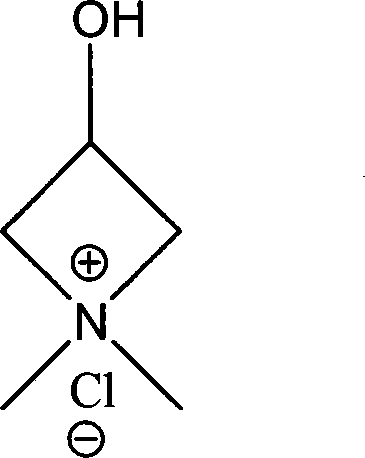Polyamide-epichlorohydrin resin cylinder adhesive
A technology of epichlorohydrin and polyamide, applied in the field of polyamide-epichlorohydrin resin sticking agent, can solve the problems of tearing, tearing, paper jamming, etc., and achieve the effects of stable performance and simple process flow
- Summary
- Abstract
- Description
- Claims
- Application Information
AI Technical Summary
Problems solved by technology
Method used
Image
Examples
Embodiment 1
[0053] Embodiment 1: with diethylenetriamine 1mol, diethyl malonate 0.9mol, solvent-free, add catalyst lipase Novozyme435, its consumption is 1% of diethylenetriamine and diethyl malonate gross mass, generally N 2 , Stir the reaction at 45°C for 6 hours to obtain a yellow-white solid prepolymer. Add water to dissolve, so that the concentration of the solution is 30%, and filter off the catalyst. Adjust the pH to 10-11 with 25% ammonia water, and add a small amount of stabilizer phosphorous acid 1.64g. 0.35 mol of epichlorohydrin is added dropwise into the prepolymer aqueous solution, and the reaction is controlled at 65° C. until the viscosity reaches 10 to 200 cps measured by the Brookfield method. Cooling with 50% sulfuric acid to adjust pH=4.0 to obtain polyamide-epichlorohydrin resin tank adhesive.
Embodiment 2
[0054] Embodiment 2: triethylenetetramine 1mol, diethyl succinate 0.95mol, solvent-free, add Novozyme4355% (reactant raw material mass ratio), logical N 2 , Stir the reaction at 50°C for 6hr to obtain a white solid prepolymer. Add water to dissolve, so that the concentration of the solution is 25%, and filter off the catalyst. Adjust pH=10-11, add a small amount of stabilizer ammonium hypophosphite 0.83g. 0.25 mol of epichlorohydrin is added dropwise into the prepolymer aqueous solution, and the reaction is controlled at 70° C. until the viscosity reaches 10 to 200 cps measured by the Brookfield method. Cool to adjust pH=4.0, pack.
Embodiment 3
[0055] Embodiment 3: with diethylenetriamine 1mol, diethyl malonate 0.95mol, add 3ml water, catalyzer lipase Novozyme435, its consumption is 1% of diethylenetriamine and diethyl malonate gross mass, generally N 2, Stir the reaction at 45°C for 6 hours to obtain a yellow-white solid prepolymer. Add water to dissolve, so that the concentration of the solution is 30%, and filter off the catalyst. Adjust the pH to 10-11 with 25% ammonia water. 0.30 mol of epichlorohydrin is added dropwise into the prepolymer aqueous solution, and the reaction is controlled at 65° C. until the viscosity reaches 10 to 200 cps measured by the Brookfield method. Cooling with 50% sulfuric acid to adjust pH=4.0 to obtain polyamide-epichlorohydrin resin tank adhesive.
[0056] Obtain the following table of polymer resin ionic strength through using potentiometric titration (aided by ion-selective electrode assay method):
[0057] Example 1
[0058] Table 1 formula of the present invention...
PUM
 Login to View More
Login to View More Abstract
Description
Claims
Application Information
 Login to View More
Login to View More - R&D
- Intellectual Property
- Life Sciences
- Materials
- Tech Scout
- Unparalleled Data Quality
- Higher Quality Content
- 60% Fewer Hallucinations
Browse by: Latest US Patents, China's latest patents, Technical Efficacy Thesaurus, Application Domain, Technology Topic, Popular Technical Reports.
© 2025 PatSnap. All rights reserved.Legal|Privacy policy|Modern Slavery Act Transparency Statement|Sitemap|About US| Contact US: help@patsnap.com



